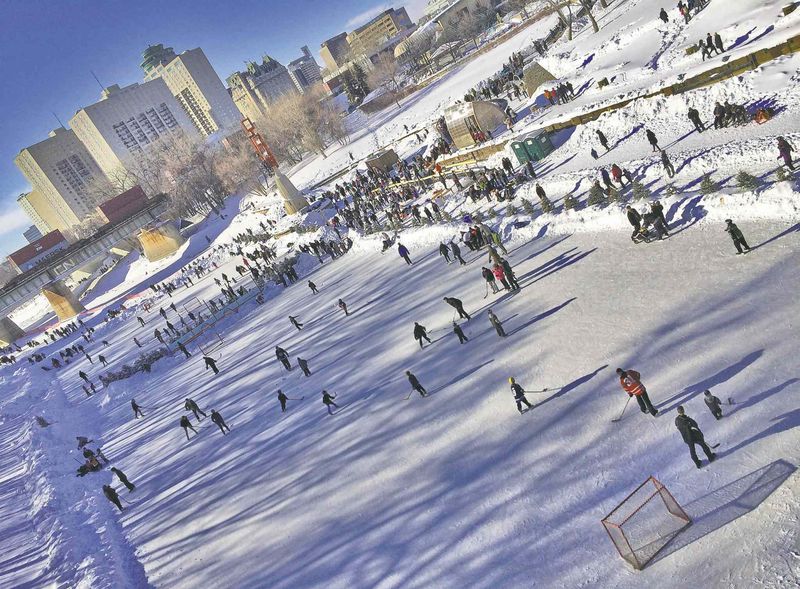By Brent Bellamy, Creative Director and Architect


The Red River Mutual Trail regularly attracts skaters to get in some winter activity. (BRENT BELLAMY)
It is mid-January, and through hard crusts of frozen breath on their tightly wrapped scarves, Winnipeggers across the city can be heard muttering to themselves "Why do I live here?"
Winnipeg doesn't have many things that can truly be described as world-class, but winter is certainly one of them. For a major city (with a population over 500,000) our January average temperatures are the fourth-coldest on Earth, rivalling cities in Siberia, Mongolia and northern China.
In response, over the last 40 years, we have worked to build a city that turns its back on winter. We defend ourselves from it like it's an enemy invader. Our climate-controlled networks sever us from the outside. Portage Avenue was for a century a bustling 12-month, outdoor shopping strip, the retail heart of the city. Then we decided to move to indoor malls, and today we zig-zag in our cars across massive parking lots from one big-box store to the next. We pushed people at our landmark intersection underground, and our sidewalks were emptied by skywalks. The default reaction to everything from segregated bike lanes to active pedestrian sidewalks and great public spaces seems to always be "It's too cold to do that in Winnipeg."
We have all heard someone from outside the province call our city Winterpeg and laugh a derogatory giggle. Imagine if we could transform that word into a badge of honour. It is difficult for a city to reach its full potential as a smart, vibrant, livable place with a resigned attitude we must endure the winter months. If Winnipeg is to be globally competitive, attracting investment, tourism and immigration, we can't simply accept a lower quality of life for half the year. Winter is part of who we are, it defines us. It can be an asset, if we make it one.
To begin changing our perception of the coldest months, Winnipeg might learn from our friends in Edmonton who have begun taking significant steps toward a long-term cultural shift in their collective perception of winter, beginning to leverage its potential as a social and economic asset that can set them apart in the world. Last year, the city took the bold step of adopting as official policy a Winter City Strategic Plan called For the Love of Winter and have drafted a clear implementation document that is now being executed.
Edmonton's Winter City plan was created through an extensive public consultation process that established four key pillars: Winter Life, Winter Design, Winter Economy and Our Winter Story. Each pillar categorizes a set of strategic goals.
-- Winter Life: The goals of this pillar are to improve winter transportation for pedestrians, cyclists and transit users as well as to simply make it easier to go outside. Strategies to implement these goals include: constructing commercial warming kiosks in public parks and plazas; creating regulations for use of fire in outdoor public spaces; encouraging neighbourhood-scale winter carnivals; constructing heated transit shelters and separated bike lanes; and prioritizing snow clearing for cyclist and pedestrian pathways.
-- Winter Design: This pillar focuses on creating a set of enforceable design guidelines that prescribe architectural and urban-planning elements to create more livable outdoor environments. These design standards focus on creating microclimates that maximize outdoor comfort by incorporating such ideas as protective wind shelter, outdoor heat sources and increased access to sunlight. Colour, public art and creative lighting elements are also encouraged.
-- Winter Economy: The economic impact of creating a vibrant winter city is seen as a multi-layered opportunity, from tourism and commercial growth to bigger picture issues such as attracting and retaining investment and young people by improving the quality of civic life year-round. Initiatives to achieve this include developing outdoor winter markets, changing zoning and alcohol bylaws to encourage a winter restaurant patio culture, supporting civic-scale festivals and public events as well as establishing educational, business and research centres that focus on winter-related industry and technology.
-- Our Winter Story: The final pillar hopes to champion awareness for the winter-city plan within Edmonton and abroad. The goal is to establish local contests, marketing and public-engagement initiatives as well as international branding and tourism campaigns that celebrate Edmonton as a world winter capital.
Over the past few years, Winnipeg has begun to informally embrace many of the ideals Edmonton has made official policy. If our city were to initiate a similar plan, there would be a strong base from which to build. Festival du Voyageur is the largest winter carnival in Western Canada, attracting approximately 100,000 visitors. Several years ago, the well-publicized battle between The Forks and Ottawa's Rideau Canal for the title of World's Longest Skating Rink raised awareness for winter activity along the rivers. Since then, the warming huts international design competition has become famous worldwide and has spawned the RAW:almond pop-up restaurant, which will again provide the experience of fine dining on the frozen Red River. A competition was held for a new restaurant design this year, won by U.K. architectural firm OS31, which proposed a dramatic tent structure currently under construction.
A great opportunity exists to follow Edmonton's lead by building on these initiatives and establishing a formal plan to transform Winnipeg's winter into an asset that makes us a global model for winter-city living and a world leader in cold-weather design. To most of the world, our frigid isolation is as exotic as any tropical island or rainforest. There is a tourism experience here that can be found in few places in the world. Through good design, we can build a city that embraces what makes it unique, improving our own quality of life and attracting visitors wanting the Winnipeg experience.
Winnipeg explodes with activities in the summer, from the Fringe and Folk festivals to the St. Norbert Farmers' Market and patios of Corydon Avenue. Edmonton is demonstrating with planning and smart design, some level of this can happen in the winter, as well. Setting goals and outlining ways to achieve them in formal policy could transform our perceptions of Winterpeg and make people instead ask themselves, "Why don't I live there?"
Brent Bellamy is senior design architect for Number Ten Architectural Group
bbellamy@numberten.com
Republished from the Winnipeg Free Press print edition January 19, 2015 B6

